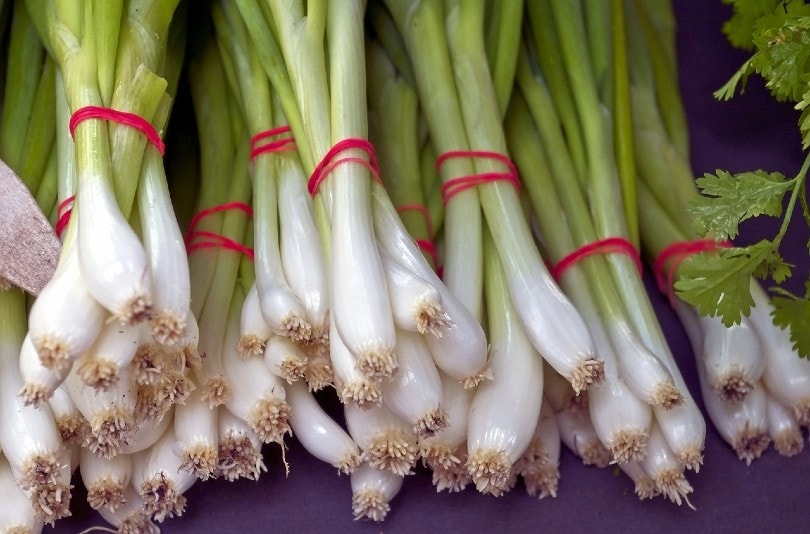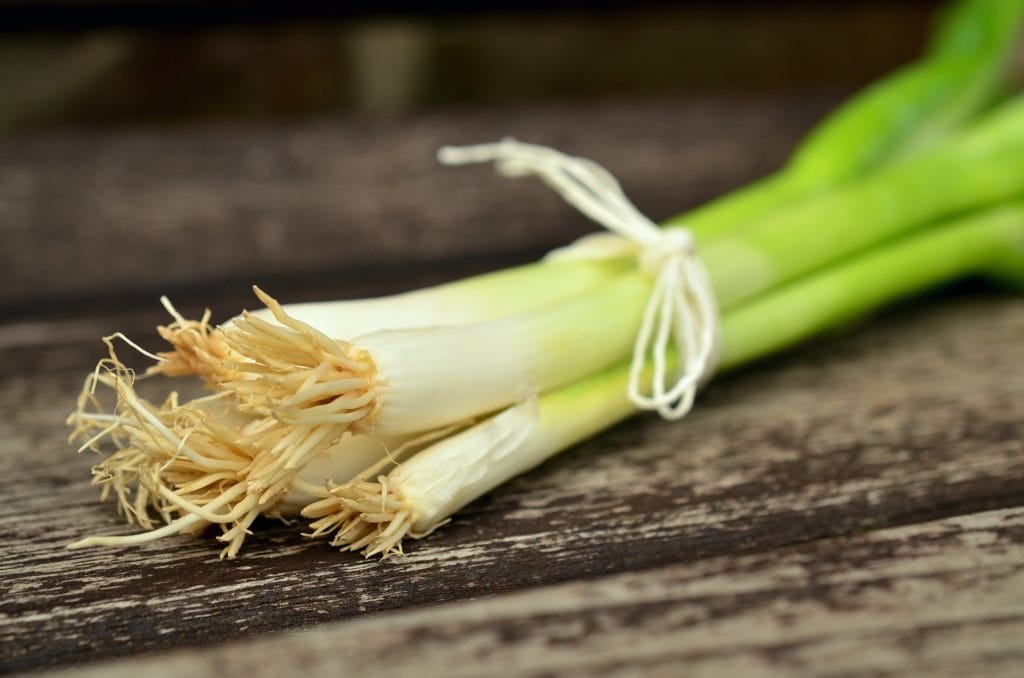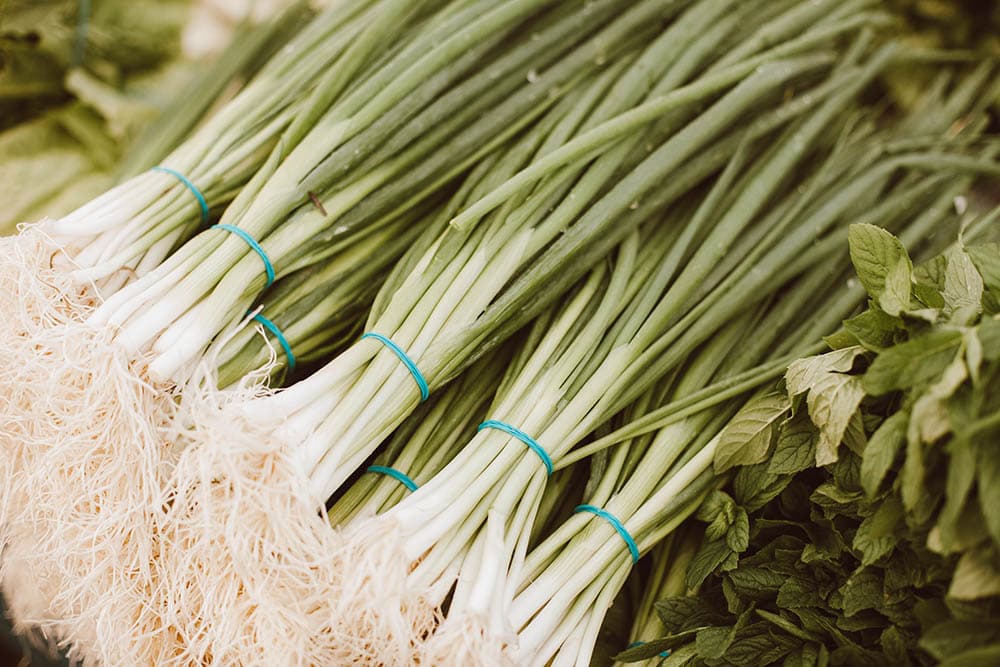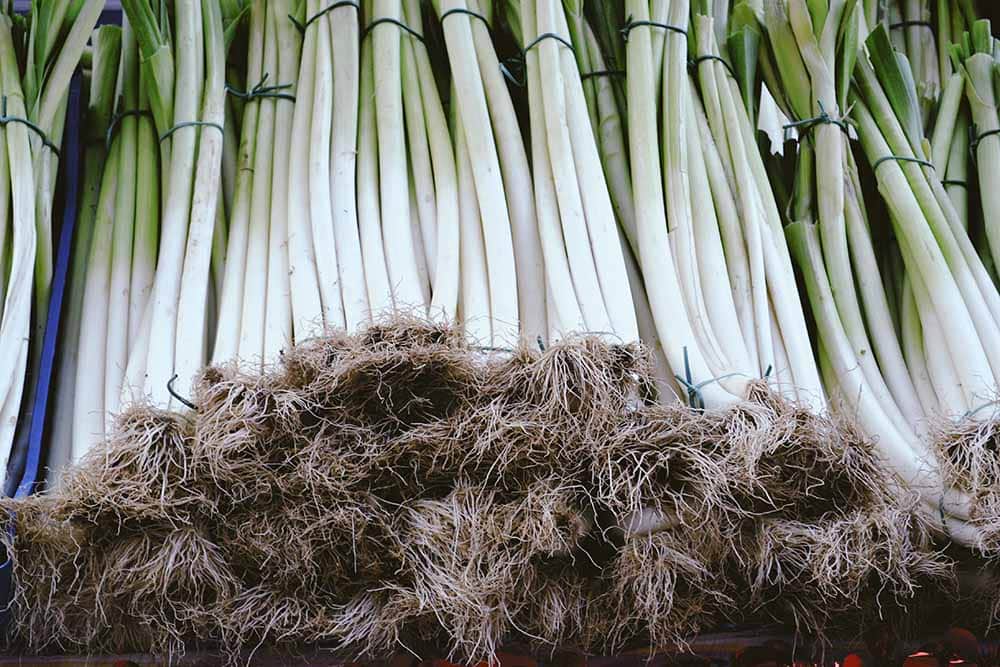8 Types of Green Onions (with Pictures)
-
- Last updated:

Do you want to add onions to your garden beds this season? Green onions are one of the most popular onions, and few people realize there are several types.
Green onions are any onions that have been picked before they’re fully grown. They are sweeter and milder than the onions that induce tears when preparing them. They are popular in various cuisines because of their sweeter taste and the fact that both their bulbs and stalks are edible.
Let’s look at the different green onions you can add to your garden or enjoy with your next meal.

The 8 Types of Green Onion
1. Basic Green Onion

| Appearance: | Green leaves, small bulb |
| Flavor: | Mild |
| Used for: | Soups, salads, stews, stir fry |
| In season: | 60-80 days after sowing |
The basic green onion is the most used type of green onion and is also referred to as a scallion. They are often confused by some with spring onions, but their bulbs are much smaller than spring onions. They are mild onions and don’t usually bring about tears when you prep them. They are commonly used in Asian-style dishes, but the onions can be eaten either raw or cooked. The white section close to the stem has the most flavor.
Growing scallions is easier than growing onions because they grow much faster. Spring-planted varieties can be harvested 60-80 days after planting or when transplants reach a height of about a foot.
2. Spring Onions

| Appearance: | Slender green stems, large bulbs |
| Flavor: | Sweet and savory |
| Used for: | Beef, chicken, fish, gravies and sauces, mashed potato |
| In season: | 8 weeks after sowing |
Many people think that green onions and spring onions are the same, but spring onions are a type of green onion and are identified by their slender stems and large bulbs. Spring onions are very young onions that have been harvested before the bulb has had a chance to swell. They earn their name Spring onions because they are usually the first growing things in the garden in spring. They have a crispy, crunchy texture and their taste is both sweet and savory, a bit milder than regular onions. They can be enjoyed raw or cooked.
Spring onions are simple to grow from seed and thrive in any fertile, well-drained soil that receives full sun. Sow spring onions at 3-week intervals from March to August for a continuous harvest. Sow spring onions in September and harvest in spring to grow them over the winter.
3. Chives

| Appearance: | Blade-like leaves, sometimes get purplish pink flowers |
| Flavor: | Mild, resembles garlic |
| Used for: | Sauces, stews, garnish, soup, sandwiches |
| In season: | 60 days after seeding |
Chives have a taste that resembles garlic and a crunchy texture, making them a popular garnish. That is why they are also considered herbs and not vegetables. Chives are distinguished by their large blade-like leaves, which can grow up to 2 feet tall. They also produce purplish-pink flowers, which are just as edible and are available all year round. Their flavor can be delicate when used in moderation, but when used too much, it can be intense and overpowering.
Chives are cold-tolerant, cool-season perennials. Planting rooted clumps in spring, after frost danger has passed, is the simplest and most successful method of growing chives. Chives are also an excellent pest repellent. They go well with carrots, celery, lettuce, peas, and tomatoes.
4. Leeks

| Appearance: | Tall, green leaves, no bulb |
| Flavor: | Sweet, earthy |
| Used for: | Soups, stew, pasta, pizza, salads |
| In season: | Fall and spring |
Leeks are the sweetest onion of all and are unique because they do not produce bulbs or cloves. They are also much larger, reaching up to 2 inches in diameter and growing as tall as 10 inches high. When raw, leeks have a crunchy texture, but when they are cooked, they become smooth. They have a mild, earthy taste and the light green part is usually the section used for cooking, while the darker leaves are generally used for garnish or sautéed.
Leeks can easily grow in raised beds, traditional garden beds, and tall containers. To thrive, leeks require plenty of nitrogen and consistent soil moisture. Once they are large enough to eat, they can be harvested anytime.
5. Chinese Onions

| Appearance: | White, bulb, thin green leaves |
| Flavor: | Mild |
| Used for: | Curries, pickled onions |
| In season: | August to September |
As the name suggests, Chinese onions are a variety found in China. They have thin green leaves and bulbs that resemble scallions and have a fresh, mild taste. Chinese onions produce flowers that bloom in August and are used as a garnish.
They are usually tolerant of various growing conditions but are not commonly available in nurseries. Chinese onions are very similar to regular chives in terms of growing requirements and should be planted in a sunny spot with loose, well-draining soil, approximately 6 inches apart. They have a pungent odor which helps act as a repellant in the garden.
6. Red Beard
| Appearance: | Red bulbs, smooth green leaves |
| Flavor: | Mild |
| Used for: | Salads, soups, stir-fry |
| In season: | 40-50 days after sowing |
This onion variety is distinguished by its red, attractive bulbs and long slender leaves. It is found in Kazakhstan and China and has a mild taste. They are enjoyed cooked or raw and are commonly used in salads, soups, and stir-fries.
Red beard is an easy vegetable to grow that is hardy and usually matures in 40–50 days. They are perennial but grown mainly as an annual.
7. Calcot
| Appearance: | Slender and smooth |
| Flavor: | Juicy and mild |
| Used for: | Grilling and open fire |
| In season: | Winter through Spring |
Calcot onions are larger than any other type of green onion and originate from Spain. They are mild when raw but become incredibly tender and develop a smoky, slightly sweet flavor when cooked. They can be used as a substitute in recipes that require green onions or spring onions.
Calcot onions grow using a specific growing technique and take over a year to develop. They are planted in trenches as a single bulb like onions, and the depth of the soil around the stems is successively increased throughout Autumn and Winter. They will sprout into 4–10 shoots.
8. Tokyo Negi
| Appearance: | Tall and green, no bulbs |
| Flavor: | Mild, sweet, and savory |
| Used for: | Salad, pasta, cream sauces, Kushiyaki, Nabemono |
| In season: | Spring and fall |
Tokyo Negi differs from common green onions because they have long white stems and no bulbs. This variety is Japanese and may be hard to find in America. They are also known as Japanese Long Green Onions and Naga Negi. They have a milder taste that is sweet and savory and can be eaten raw or cooked. They can be cooked with pasta, salads, and cream sauces but are most commonly used to make traditional Japanese dishes like Kushiyaki and Nabemono.
Tokyo Negi must not be exposed to the sun to form the elongated white shank. As a result, the more dirt you push around the plant’s base, the higher the white shank grows as it reaches for sunlight.

Conclusion
Green onions are a popular choice in many savory dishes and are a great staple to any kitchen or garden bed. The most commonly known green onions are easy to grow and are available almost all season to add to your dishes. We hope this article broadened your knowledge and interest in green onions, and you feel inspired to cook, garnish, plant, and enjoy the sweet taste of green onions.
Featured Image Credit: MikeGoad, Pixabay
Contents

